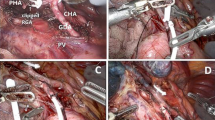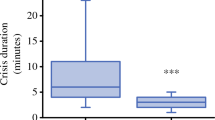Abstract
Background
Adrenalectomy for pheochromocytoma is considered to be a challenging procedure because of the risk of hemodynamic instability (HI), which is poorly defined and unpredictable. The objective of this retrospective study from a prospectively maintained database was to determine the predictive factors for perioperative HI, which is defined as a morbidity-related variable, in patients undergoing unilateral laparoscopic adrenalectomy (LA) for pheochromocytoma.
Methods
A total of 149 patients with unilateral pheochromocytoma undergoing LA were included. First, HI was defined using independent hemodynamic variables associated with perioperative morbidity. Next, a multivariable logistic regression analysis was performed to determine the independent preoperative risk factors for HI.
Results
There was no postoperative mortality, and the overall morbidity rate was 10.7 %. The use of a cumulative dose of norepinephrine >5 mg was the only independent hemodynamic predictive factor for postoperative complications; thus, this variable was used to define HI. A multivariate analysis revealed that a symptomatic high preoperative blood pressure (p = 0.003) and a ten-fold increase in urinary metanephrine and/or normetanephrine levels (p < 0.0001) were significant predictors of HI. When no predictive factors were present, the risk of HI and the postoperative morbidity were 1.5 and 4.3 %, respectively. However, when two predictive factors were present, the HI risk and the postoperative morbidity were 53.8 and 30.8 %, respectively.
Conclusion
Perioperative HI, defined as the need for a cumulative dose of norepinephrine >5 mg, is significantly associated with postoperative morbidity and can be predicted by symptomatic preoperative high blood pressure and above a ten-fold increase in urinary metanephrine and/or normetanephrine levels.
Similar content being viewed by others
References
Gagner M, Lacroix A, Bolte E (1992) Laparoscopic adrenalectomy in Cushing’s syndrome and pheochromocytoma. N Engl J Med 327(14):1033
Assalia A, Gagner M (2004) Laparoscopic adrenalectomy. Br J Surg 91(10):1259–1274
Gaujoux S et al (2011) Risk factors for conversion and complications after unilateral laparoscopic adrenalectomy. Br J Surg 98(10):1392–1399
Gagner M et al (1996) Is laparoscopic adrenalectomy indicated for pheochromocytomas? Surgery 120(6):1076–1079 (discussion 1079-80)
Kim AW et al (2004) Outcome of laparoscopic adrenalectomy for pheochromocytomas vs aldosteronomas. Arch Surg 139(5):526–529 (discussion 529-31)
Fernandez-Cruz L et al (1996) Laparoscopic approach to pheochromocytoma: hemodynamic changes and catecholamine secretion. World J Surg 20(7):762–768 (discussion 768)
Inabnet WB et al (2000) Comparison of the hemodynamic parameters of open and laparoscopic adrenalectomy for pheochromocytoma. World J Surg 24(5):574–578
Shen WT et al (2010) One hundred two patients with pheochromocytoma treated at a single institution since the introduction of laparoscopic adrenalectomy. Arch Surg 145(9):893–897
Gumbs AA, Gagner M (2006) Laparoscopic adrenalectomy. Best Pract Res Clin Endocrinol Metab 20(3):483–499
Shen WT, Sturgeon C, Duh QY (2005) From incidentaloma to adrenocortical carcinoma: the surgical management of adrenal tumors. J Surg Oncol 89(3):186–192
Walz MK et al (2006) Laparoscopic and retroperitoneoscopic treatment of pheochromocytomas and retroperitoneal paragangliomas: results of 161 tumors in 126 patients. World J Surg 30(5):899–908
Nau P et al (2010) Pheochromocytoma does not increase risk in laparoscopic adrenalectomy. Surg Endosc 24(11):2760–2764
Paganini AM et al (2014) Laparoscopic transperitoneal anterior adrenalectomy in pheochromocytoma: experience in 62 patients. Surg Endosc 28(9):2683–2689
Cheah WK et al (2002) Laparoscopic adrenalectomy for pheochromocytoma. World J Surg 26(8):1048–1051
Jaroszewski DE et al (2003) Laparoscopic adrenalectomy for pheochromocytoma. Mayo Clin Proc 78(12):1501–1504
Solorzano CC et al (2007) Outcomes of pheochromocytoma management in the laparoscopic era. Ann Surg Oncol 14(10):3004–3010
Berber E et al (2009) Comparison of laparoscopic transabdominal lateral versus posterior retroperitoneal adrenalectomy. Surgery 146(4):621–625 (discussion 625-6)
Perry KA et al (2010) Laparoscopic adrenalectomy for large unilateral pheochromocytoma: experience in a large academic medical center. Surg Endosc 24(6):1462–1467
Lentschener C et al (2009) Increased arterial pressure is not predictive of hemodynamic instability in patients undergoing adrenalectomy for phaeochromocytoma. Acta Anaesthesiol Scand 53(4):522–527
Plouin PF et al (2001) Factors associated with perioperative morbidity and mortality in patients with pheochromocytoma: analysis of 165 operations at a single center. J Clin Endocrinol Metab 86(4):1480–1486
Bruynzeel H et al (2010) Risk factors for hemodynamic instability during surgery for pheochromocytoma. J Clin Endocrinol Metab 95(2):678–685
Dindo D, Demartines N, Clavien PA (2004) Classification of surgical complications: a new proposal with evaluation in a cohort of 6336 patients and results of a survey. Ann Surg 240(2):205–213
Lee TH et al (1999) Derivation and prospective validation of a simple index for prediction of cardiac risk of major noncardiac surgery. Circulation 100(10):1043–1049
Behnia R, Molteni A, Igic R (2003) Angiotensin-converting enzyme inhibitors: mechanisms of action and implications in anesthesia practice. Curr Pharm Des 9(9):763–776
Gilman A, Limbird L, Hardman J (2001) Goodman & Gilman‘s: the pharmacological basis of therapeutics. McGraw-Hill Professional, New York
Gagner M et al (1994) Laparoscopic adrenalectomy. The importance of a flank approach in the lateral decubitus position. Surg Endosc 8(2):135–138
Desmonts JM et al (1977) Anaesthetic management of patients with phaeochromocytoma. A review of 102 cases. Br J Anaesth 49(10):991–998
Galetta F et al (2010) Cardiovascular complications in patients with pheochromocytoma: a mini-review. Biomed Pharmacother 64(7):505–509
Tauzin-Fin P et al (2004) Effects of perioperative alpha1 block on hemodynamic control during laparoscopic surgery for phaeochromocytoma. Br J Anaesth 92(4):512–517
Flavio Rocha M et al (2004) Laparoscopic surgery for pheochromocytoma. Eur Urol 45(2):226–232
Hull CJ (1986) Phaeochromocytoma. Diagnosis, preoperative preparation and anaesthetic management. Br J Anaesth 58(12):1453–1468
Prys-Roberts C (2000) Phaeochromocytoma—recent progress in its management. Br J Anaesth 85(1):44–57
Aliyev S et al (2013) Robotic versus laparoscopic adrenalectomy for pheochromocytoma. Ann Surg Oncol 20(13):4190–4194
Conzo G et al (2013) Laparoscopic adrenalectomy, a safe procedure for pheochromocytoma. A retrospective review of clinical series. Int J Surg 11(2):152–156
Toniato A et al (2007) Is the laparoscopic adrenalectomy for pheochromocytoma the best treatment? Surgery 141(6):723–727
Toniato A et al (2007) Laparoscopic adrenalectomy for pheochromocytoma: is it really more difficult? Surg Endosc 21(8):1323–1326
Chang RY et al (2014) High pre-operative urinary norepinephrine is an independent determinant of peri-operative hemodynamic instability in unilateral pheochromocytoma/paraganglioma removal. World J Surg 38(9):2317–2323
Lenders JW et al (2005) Phaeochromocytoma. Lancet 366(9486):665–675
Kinney MA et al (2000) Perianesthetic risks and outcomes of pheochromocytoma and paraganglioma resection. Anesth Analg 91(5):1118–1123
Weingarten TN et al (2010) Comparison of two preoperative medical management strategies for laparoscopic resection of pheochromocytoma. Urology 76(2):508.e6–508.e11
Brunaud, L et al (2015) Predictive factors for postoperative morbidity after laparoscopic adrenalectomy for pheochromocytoma: a multicenter retrospective analysis in 225 patients. Surg Endosc. doi:10.1007/s00464-015-4294-7
Rady MY, Ryan T, Starr NJ (1998) Perioperative determinants of morbidity and mortality in elderly patients undergoing cardiac surgery. Crit Care Med 26(2):225–235
Gomes RV et al (2007) A first postoperative day predictive score of mortality for cardiac surgery. Ann Thorac Cardiovasc Surg 13(3):159–164
Gaies MG et al (2010) Vasoactive-inotropic score as a predictor of morbidity and mortality in infants after cardiopulmonary bypass. Pediatr Crit Care Med 11(2):234–238
Davidson J et al (2012) Prospective validation of the vasoactive-inotropic score and correlation to short-term outcomes in neonates and infants after cardiothoracic surgery. Intensive Care Med 38(7):1184–1190
Wilkman E et al (2013) Association between inotrope treatment and 90-day mortality in patients with septic shock. Acta Anaesthesiol Scand 57(4):431–442
Inoue T et al (2013) Medical and surgical management after spinal cord injury: vasopressor usage, early surgery and complications. J Neurotrauma 31(3):248–291
Pacak K et al (2007) Pheochromocytoma: recommendations for clinical practice from the first international symposium. October 2005. Nat Clin Pract Endocrinol Metab 3(2):92–102
Pacak K (2007) Preoperative management of the pheochromocytoma patient. J Clin Endocrinol Metab 92(11):4069–4079
Prys-Roberts C, Farndon JR (2002) Efficacy and safety of doxazosin for perioperative management of patients with pheochromocytoma. World J Surg 26(8):1037–1042
Lentschener C et al (2011) Point of controversy: perioperative care of patients undergoing pheochromocytoma removal-time for a reappraisal? Eur J Endocrinol 165(3):365–373
Gaujoux S, Lentschener C (2010) Re: Weingarten et al.: comparison of two preoperative medical management strategies for laparoscopic resection of pheochromocytoma (Urology 2010;76:508). Urology 76(6):1526 (author reply 1526-7)
Author information
Authors and Affiliations
Corresponding author
Ethics declarations
Disclosures
Sébastien Gaujoux, Stéphane Bonnet, Claude Lentschener, Jean-Marc Thillois, Denis Duboc, Jérôme Bertherat, Charles Marc Samama, and Bertrand Dousset have no conflicts of interest or financial ties to disclose.
Additional information
Sébastien Gaujoux and Stéphane Bonnet should be considered as first co-authors.
Rights and permissions
About this article
Cite this article
Gaujoux, S., Bonnet, S., Lentschener, C. et al. Preoperative risk factors of hemodynamic instability during laparoscopic adrenalectomy for pheochromocytoma. Surg Endosc 30, 2984–2993 (2016). https://doi.org/10.1007/s00464-015-4587-x
Received:
Accepted:
Published:
Issue Date:
DOI: https://doi.org/10.1007/s00464-015-4587-x




